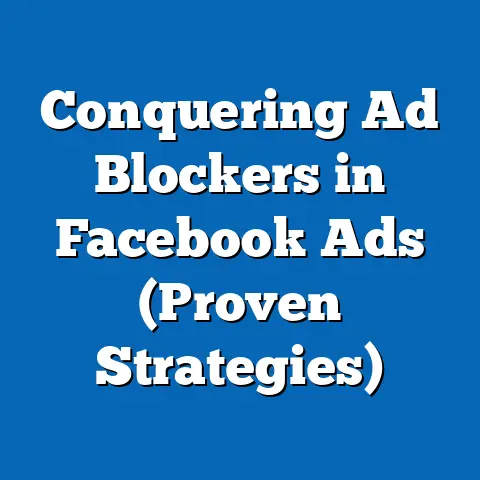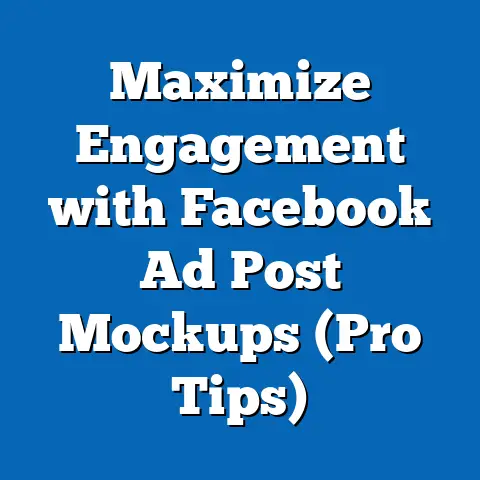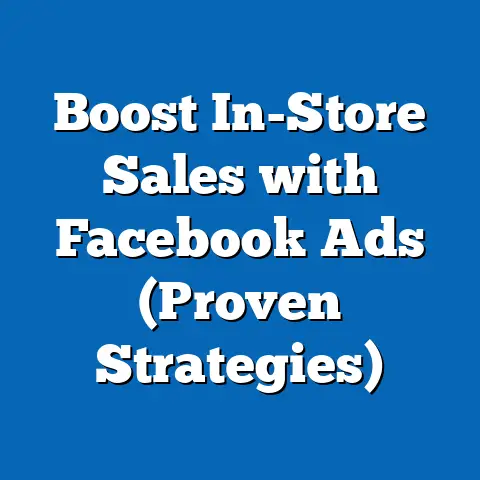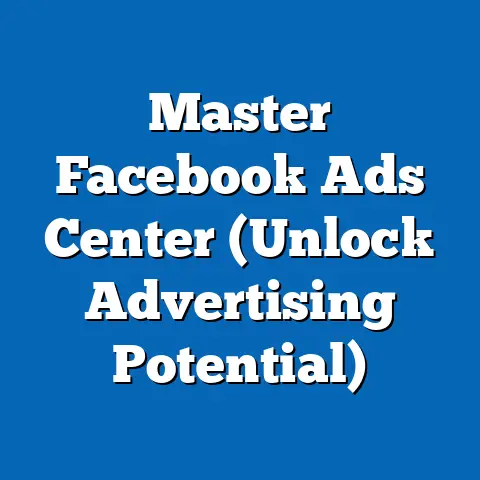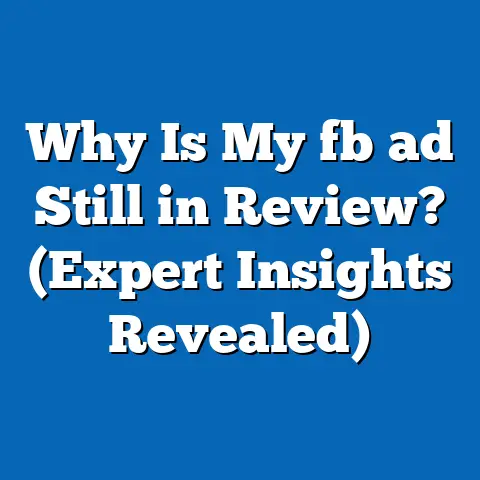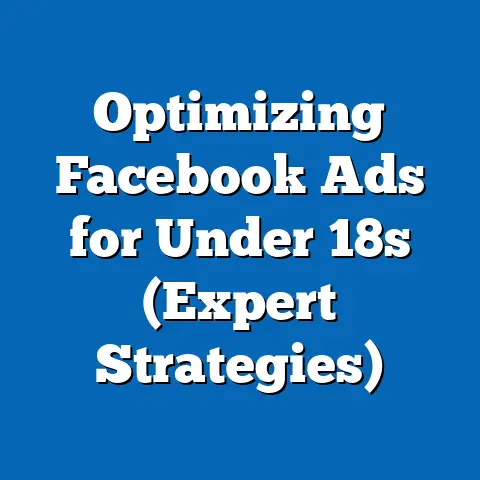Maximize Engagement: Using Facebook Ads for People Pages (Strategic Insights)
Imagine you’re someone with severe allergies. You can’t just wander through a field of wildflowers without a plan. You need to know what triggers your reactions, understand the landscape, and have a strategy for navigating it safely. Similarly, businesses diving into Facebook advertising can’t just throw money at ads and hope for the best. They need a strategic plan, a deep understanding of their audience, and the ability to react and adapt to the ever-changing Facebook ecosystem.
Just as allergy sufferers need to be aware of their triggers and the nuances of their condition, businesses must understand their audience’s preferences, behaviors, and pain points to create effective Facebook ad campaigns. I’ve seen countless businesses launch campaigns with beautifully designed ads, only to be met with crickets. Why? Because they skipped the crucial step of understanding who they were trying to reach and what would resonate with them.
Facebook, with its billions of active users, is a goldmine for businesses seeking to connect with their target audience. But simply being present on the platform isn’t enough. You need to actively engage your audience, spark conversations, and build meaningful relationships. This is where Facebook ads come in. They offer a powerful tool to reach the right people with the right message, at the right time. But, just like managing allergies, success requires a proactive, informed approach.
This guide is designed to equip you with the knowledge and strategies you need to maximize engagement through Facebook ads for your “People Page” (a Facebook page representing a public figure, personality, or individual). We’ll delve into the intricacies of the Facebook advertising platform, explore the art of crafting compelling content, and uncover the secrets to optimizing your ad performance. By the end of this guide, you’ll have a clear roadmap for creating Facebook ad campaigns that not only reach your target audience but also inspire them to take action.
1. Understanding the Facebook Ecosystem
Before diving into the specifics of ad creation and optimization, it’s crucial to understand the fundamental building blocks of the Facebook ecosystem. Think of it as understanding the pollen count before venturing outdoors.
1.1 Overview of Facebook’s Advertising Platform
Facebook’s advertising platform is a complex beast, but once you tame it, it can be incredibly rewarding. It offers a diverse range of ad formats, each designed to achieve specific objectives.
-
Carousel Ads: These ads allow you to showcase multiple images or videos within a single ad, making them perfect for highlighting a range of products or features. I’ve found them particularly effective for e-commerce businesses looking to showcase their latest collections.
-
Video Ads: Video is king in the digital world, and Facebook is no exception. Video ads can be used to tell compelling stories, demonstrate product features, or simply capture attention. Short, engaging videos tend to perform best.
-
Image Ads: A classic ad format, image ads are simple yet effective. The key is to use high-quality, visually appealing images that grab attention. I’ve seen image ads drive significant results for businesses that focus on showcasing a single product or service.
-
Story Ads: These ads appear within Facebook Stories, offering a full-screen, immersive experience. They’re ideal for capturing attention and driving quick actions.
-
Collection Ads: Designed for e-commerce, collection ads allow users to browse and purchase products directly from the ad. They provide a seamless shopping experience and can be highly effective for driving sales.
Carousel Ads: These ads allow you to showcase multiple images or videos within a single ad, making them perfect for highlighting a range of products or features. I’ve found them particularly effective for e-commerce businesses looking to showcase their latest collections.
Video Ads: Video is king in the digital world, and Facebook is no exception. Video ads can be used to tell compelling stories, demonstrate product features, or simply capture attention. Short, engaging videos tend to perform best.
Image Ads: A classic ad format, image ads are simple yet effective. The key is to use high-quality, visually appealing images that grab attention. I’ve seen image ads drive significant results for businesses that focus on showcasing a single product or service.
Story Ads: These ads appear within Facebook Stories, offering a full-screen, immersive experience. They’re ideal for capturing attention and driving quick actions.
Collection Ads: Designed for e-commerce, collection ads allow users to browse and purchase products directly from the ad. They provide a seamless shopping experience and can be highly effective for driving sales.
Beyond the ad formats, Facebook’s targeting options are what truly set it apart. You can target users based on:
- Demographics: Age, gender, location, education, and more.
- Interests: Hobbies, passions, and topics they’ve shown interest in.
- Behaviors: Past purchases, website visits, and other online activities.
- Custom Audiences: You can upload your own customer lists or create audiences based on website traffic or app activity.
- Lookalike Audiences: Facebook can create audiences that are similar to your existing customers, expanding your reach to new potential customers.
Why does all of this matter for engagement? Because relevant ads are engaging ads. If you’re showing a skateboarding ad to someone who loves knitting, you’re wasting your money and annoying your audience. By leveraging Facebook’s targeting options, you can ensure that your ads are reaching the people who are most likely to be interested in your message.
Takeaway: Familiarize yourself with the various ad formats and targeting options available on Facebook. The more precisely you can target your audience, the more effective your ads will be.
1.2 The Role of Algorithms in Engagement
Facebook’s algorithm is the gatekeeper of content. It decides which posts and ads users see in their newsfeeds. Understanding how this algorithm works is crucial for maximizing engagement.
The algorithm prioritizes content based on a variety of factors, including:
- Relevance: How relevant the content is to the user’s interests and past behavior.
- Engagement: How many people are liking, commenting, and sharing the content.
- Recency: How recently the content was posted.
- Relationship: The user’s relationship with the page or person posting the content.
Engagement metrics (likes, comments, shares, saves, and clicks) play a significant role in determining ad visibility. The more engagement your ad receives, the more likely it is to be shown to a wider audience. This creates a positive feedback loop – high engagement leads to greater visibility, which in turn leads to even more engagement.
I’ve learned over the years that focusing on creating genuinely valuable and engaging content is the best way to appease the algorithm. Trying to game the system with clickbait or other shady tactics might provide a temporary boost, but it will ultimately backfire.
Takeaway: Create content that is relevant, engaging, and timely. Encourage interaction by asking questions, running polls, and responding to comments.
1.3 The Importance of Audience Insights
Facebook Audience Insights is a powerful tool that provides valuable data about your target audience. It allows you to explore their demographics, interests, behaviors, and more. This information can be used to tailor your ads for maximum engagement.
With Audience Insights, you can discover:
- Demographics: Age, gender, location, education level, relationship status, job titles, and more.
- Interests: Pages they like, topics they’re interested in, and activities they enjoy.
- Behaviors: Purchase history, device usage, travel habits, and more.
- Household: Household income, home ownership status, and household size.
By analyzing this data, you can gain a deeper understanding of your audience and create ads that resonate with them on a personal level. For example, if you’re targeting millennials, you might discover that they’re highly interested in sustainable products and experiences. You can then tailor your ad copy and visuals to reflect these interests.
I remember working with a local bakery that was struggling to attract new customers. By using Audience Insights, we discovered that their target audience was primarily interested in healthy eating and organic ingredients. We then created ads that highlighted the bakery’s use of organic flour and natural sweeteners, which resulted in a significant increase in foot traffic.
Takeaway: Use Facebook Audience Insights to gain a deeper understanding of your target audience. Tailor your ads to reflect their demographics, interests, and behaviors.
2. Crafting Compelling Content for People Pages
Once you understand the Facebook ecosystem and your target audience, it’s time to craft compelling content that captures their attention and inspires them to take action.
2.1 The Power of Storytelling
Storytelling is one of the most powerful tools in your marketing arsenal. Stories can create emotional connections with your audience, build trust, and make your brand more relatable.
People connect with stories on a deeper level than they do with facts and figures. A well-told story can capture their imagination, transport them to another world, and leave a lasting impression.
I’ve found that the most effective stories are those that are authentic, relatable, and emotionally resonant. They don’t have to be elaborate or dramatic; sometimes, the simplest stories are the most powerful.
Here are some examples of successful ad campaigns that utilized storytelling effectively:
-
Dove’s “Real Beauty” Campaign: This campaign challenged traditional beauty standards and celebrated the diversity of women’s bodies. It resonated with audiences because it was authentic, empowering, and emotionally resonant.
-
Always’ “Like a Girl” Campaign: This campaign challenged the negative connotations associated with the phrase “like a girl” and encouraged girls to embrace their strength and confidence. It sparked a national conversation and generated widespread support.
-
Airbnb’s “Belong Anywhere” Campaign: This campaign focused on the power of travel to connect people and foster a sense of belonging. It resonated with audiences because it tapped into their desire for adventure and connection.
Dove’s “Real Beauty” Campaign: This campaign challenged traditional beauty standards and celebrated the diversity of women’s bodies. It resonated with audiences because it was authentic, empowering, and emotionally resonant.
Always’ “Like a Girl” Campaign: This campaign challenged the negative connotations associated with the phrase “like a girl” and encouraged girls to embrace their strength and confidence. It sparked a national conversation and generated widespread support.
Airbnb’s “Belong Anywhere” Campaign: This campaign focused on the power of travel to connect people and foster a sense of belonging. It resonated with audiences because it tapped into their desire for adventure and connection.
Takeaway: Use storytelling to create emotional connections with your audience. Share authentic, relatable stories that showcase your brand’s values and personality.
2.2 Visual Content: More Than Just Eye Candy
In the fast-paced world of social media, visual content is essential for capturing attention. But it’s not enough to simply use pretty pictures. Your visuals should be high-quality, relevant, and engaging.
Different types of visual content have different impacts on engagement:
-
Images: High-quality images can quickly capture attention and convey a message. Use images that are visually appealing, relevant to your brand, and optimized for Facebook’s dimensions.
-
Videos: Videos are highly engaging and can be used to tell stories, demonstrate product features, or simply capture attention. Keep your videos short, engaging, and optimized for mobile viewing.
-
Infographics: Infographics can be used to present complex information in a visually appealing and easy-to-understand format. Use infographics to educate your audience, share data, or highlight key insights.
Images: High-quality images can quickly capture attention and convey a message. Use images that are visually appealing, relevant to your brand, and optimized for Facebook’s dimensions.
Videos: Videos are highly engaging and can be used to tell stories, demonstrate product features, or simply capture attention. Keep your videos short, engaging, and optimized for mobile viewing.
Infographics: Infographics can be used to present complex information in a visually appealing and easy-to-understand format. Use infographics to educate your audience, share data, or highlight key insights.
I’ve seen brands significantly boost engagement by simply upgrading their visual content. Investing in professional photography or videography can make a huge difference.
Takeaway: Use high-quality, visually appealing visuals that are relevant to your brand and optimized for Facebook’s dimensions. Experiment with different types of visual content to see what resonates best with your audience.
2.3 Crafting Engaging Copy
Your ad copy is just as important as your visuals. It should be clear, concise, and compelling. It should also include a strong call-to-action that tells your audience what you want them to do.
Here are some tips for writing compelling ad copy:
-
Know Your Audience: Write in a language that resonates with your target audience. Use their vocabulary and address their pain points.
-
Highlight Benefits: Focus on the benefits of your product or service, rather than just the features. Tell your audience how your product or service will make their lives better.
-
Use Strong Calls-to-Action: Tell your audience what you want them to do. Use clear and concise calls-to-action, such as “Learn More,” “Shop Now,” or “Sign Up Today.”
-
Keep it Short and Sweet: People have short attention spans, so keep your ad copy concise and to the point.
-
Use Humor: If appropriate for your brand, use humor to capture attention and make your ad more memorable.
Know Your Audience: Write in a language that resonates with your target audience. Use their vocabulary and address their pain points.
Highlight Benefits: Focus on the benefits of your product or service, rather than just the features. Tell your audience how your product or service will make their lives better.
Use Strong Calls-to-Action: Tell your audience what you want them to do. Use clear and concise calls-to-action, such as “Learn More,” “Shop Now,” or “Sign Up Today.”
Keep it Short and Sweet: People have short attention spans, so keep your ad copy concise and to the point.
Use Humor: If appropriate for your brand, use humor to capture attention and make your ad more memorable.
The tone and voice of your ad copy should align with your brand’s identity. If your brand is playful and irreverent, your ad copy should reflect that. If your brand is serious and professional, your ad copy should be more formal.
Takeaway: Write clear, concise, and compelling ad copy that highlights the benefits of your product or service and includes a strong call-to-action. Ensure that your tone and voice align with your brand’s identity.
3. Optimizing Ad Performance
Creating great content is only half the battle. You also need to optimize your ad performance to ensure that you’re getting the most bang for your buck.
3.1 Setting Clear Objectives
Before launching any ad campaign, it’s crucial to define what engagement means for your business. Are you looking to increase brand awareness, generate leads, drive website traffic, or boost sales?
Your objectives will influence your ad format, targeting options, and call-to-action. For example, if you’re looking to increase brand awareness, you might focus on creating visually appealing video ads that tell your brand’s story. If you’re looking to generate leads, you might use a lead generation ad that asks users to submit their contact information.
It’s also important to set SMART goals for your Facebook ad campaigns. SMART goals are:
- Specific: Clearly defined and focused.
- Measurable: Quantifiable and trackable.
- Achievable: Realistic and attainable.
- Relevant: Aligned with your overall business objectives.
- Time-bound: With a defined deadline.
For example, instead of setting a goal of “increase brand awareness,” you might set a SMART goal of “increase brand awareness by 20% in the next three months, as measured by website traffic and social media mentions.”
Takeaway: Define what engagement means for your business and set SMART goals for your Facebook ad campaigns.
3.2 A/B Testing: The Secret to Success
A/B testing, also known as split testing, is a technique that involves creating two versions of an ad and testing them against each other to see which one performs better. This allows you to identify the most effective ad copy, visuals, and targeting options.
A/B testing is essential for optimizing your ad performance. It allows you to make data-driven decisions and continuously improve your campaigns.
Here’s a step-by-step guide on how to conduct A/B tests effectively:
-
Identify a Variable to Test: Choose one element of your ad to test, such as the headline, image, or call-to-action.
-
Create Two Versions of Your Ad: Create two versions of your ad that are identical except for the variable you’re testing.
-
Run Your Ads: Run your ads for a set period of time, targeting the same audience.
-
Analyze the Results: After the testing period, analyze the results to see which ad performed better.
-
Implement the Winning Version: Implement the winning version of your ad and continue to test other variables.
Identify a Variable to Test: Choose one element of your ad to test, such as the headline, image, or call-to-action.
Create Two Versions of Your Ad: Create two versions of your ad that are identical except for the variable you’re testing.
Run Your Ads: Run your ads for a set period of time, targeting the same audience.
Analyze the Results: After the testing period, analyze the results to see which ad performed better.
Implement the Winning Version: Implement the winning version of your ad and continue to test other variables.
I’ve seen A/B testing completely transform struggling campaigns. By iteratively testing different elements, you can gradually optimize your ads for maximum performance.
Takeaway: Conduct A/B tests to identify the most effective ad copy, visuals, and targeting options. Use the results to make data-driven decisions and continuously improve your campaigns.
3.3 Analyzing and Interpreting Data
Facebook Ads Manager provides a wealth of data about your ad performance. It’s important to track key performance indicators (KPIs) to measure the success of your campaigns.
Some key KPIs to track for engagement include:
- Click-Through Rate (CTR): The percentage of people who saw your ad and clicked on it.
- Engagement Rate: The percentage of people who interacted with your ad (likes, comments, shares, saves).
- Cost Per Click (CPC): The average cost you pay each time someone clicks on your ad.
- Cost Per Engagement (CPE): The average cost you pay each time someone interacts with your ad.
- Reach: The number of people who saw your ad.
- Frequency: The average number of times each person saw your ad.
By analyzing this data, you can gain insights into what’s working and what’s not. For example, if your CTR is low, it might indicate that your ad copy or visuals are not compelling enough. If your CPE is high, it might indicate that you’re targeting the wrong audience or that your ad is not relevant to their interests.
I always recommend setting up custom dashboards in Ads Manager to track the metrics that are most important to your business. This allows you to quickly identify trends and make adjustments to your campaigns.
Takeaway: Track key performance indicators (KPIs) in Facebook Ads Manager to measure the success of your campaigns. Analyze the data to identify what’s working and what’s not, and make adjustments accordingly.
4. Leveraging Engagement Strategies
Beyond creating compelling content and optimizing your ad performance, there are several engagement strategies you can leverage to maximize the impact of your Facebook ads.
4.1 Interactive Ads: Engaging the Audience
Interactive ads are a great way to capture attention and encourage engagement. They allow users to actively participate in the ad experience, making it more memorable and impactful.
Some examples of interactive ads include:
-
Poll Ads: These ads allow users to vote on a question or topic, providing valuable insights and encouraging interaction.
-
Quiz Ads: These ads allow users to test their knowledge on a specific topic, providing entertainment and driving engagement.
-
Augmented Reality (AR) Ads: These ads allow users to interact with your product or service in a virtual environment, providing a unique and immersive experience.
Poll Ads: These ads allow users to vote on a question or topic, providing valuable insights and encouraging interaction.
Quiz Ads: These ads allow users to test their knowledge on a specific topic, providing entertainment and driving engagement.
Augmented Reality (AR) Ads: These ads allow users to interact with your product or service in a virtual environment, providing a unique and immersive experience.
I’ve found that interactive ads are particularly effective for brands that want to generate leads or collect user data. By offering a fun and engaging experience, you can incentivize users to provide their contact information.
Takeaway: Explore the use of polls, quizzes, and interactive content in your Facebook ads. Interactive ads can boost engagement rates and provide valuable insights into your audience’s preferences.
4.2 User-Generated Content: Harnessing the Power of Community
User-generated content (UGC) is any content that is created by your customers or fans, such as photos, videos, reviews, or testimonials. UGC is highly authentic and relatable, making it a powerful tool for building trust and driving engagement.
You can encourage and utilize UGC in your Facebook ads by:
-
Running Contests and Giveaways: Encourage users to submit photos or videos showcasing your product or service.
-
Featuring Customer Reviews and Testimonials: Highlight positive reviews and testimonials in your ads to build credibility.
-
Creating a Hashtag Campaign: Encourage users to share their experiences with your brand using a specific hashtag.
Running Contests and Giveaways: Encourage users to submit photos or videos showcasing your product or service.
Featuring Customer Reviews and Testimonials: Highlight positive reviews and testimonials in your ads to build credibility.
Creating a Hashtag Campaign: Encourage users to share their experiences with your brand using a specific hashtag.
I worked with a clothing retailer that launched a UGC campaign asking customers to share photos of themselves wearing their clothes. The campaign generated hundreds of submissions and resulted in a significant increase in brand awareness and sales.
Takeaway: Encourage and utilize user-generated content in your Facebook ads. UGC is highly authentic and relatable, making it a powerful tool for building trust and driving engagement.
4.3 Retargeting: Keeping the Conversation Going
Retargeting is a technique that allows you to show ads to people who have previously interacted with your brand, such as visiting your website, watching a video, or engaging with your Facebook page. Retargeting is highly effective for maintaining engagement and driving conversions.
By retargeting previous visitors, you can remind them of your brand and encourage them to take the next step, such as making a purchase or signing up for your email list.
Here are some strategies for creating retargeting ads that resonate with previous visitors:
-
Offer a Discount or Promotion: Encourage previous visitors to return to your website by offering a discount or promotion.
-
Showcase Relevant Products or Services: Show previous visitors products or services that they previously viewed on your website.
-
Provide Social Proof: Highlight positive reviews and testimonials from other customers.
Offer a Discount or Promotion: Encourage previous visitors to return to your website by offering a discount or promotion.
Showcase Relevant Products or Services: Show previous visitors products or services that they previously viewed on your website.
Provide Social Proof: Highlight positive reviews and testimonials from other customers.
I’ve seen retargeting campaigns consistently outperform other types of Facebook ads. By focusing on people who have already shown interest in your brand, you can significantly increase your chances of success.
Takeaway: Utilize retargeting to maintain engagement and drive conversions. Create retargeting ads that resonate with previous visitors by offering discounts, showcasing relevant products, and providing social proof.
5. Case Studies and Success Stories
To illustrate the power of Facebook ads for people pages, let’s take a look at some case studies and success stories.
5.1 Highlight Successful Campaigns
-
Tony Robbins: The renowned life coach leverages Facebook ads to promote his events, books, and online programs. He uses a combination of video ads, lead generation ads, and retargeting to reach his target audience and drive conversions. His ads often feature testimonials from satisfied customers and highlight the transformative power of his teachings.
-
Marie Forleo: The entrepreneur and online business expert uses Facebook ads to build her email list and promote her online courses. She creates visually appealing image ads and video ads that showcase her expertise and personality. She also uses retargeting to target people who have previously visited her website or engaged with her content.
-
Gary Vaynerchuk: The entrepreneur and social media guru uses Facebook ads to promote his books, podcasts, and speaking engagements. He uses a combination of video ads, image ads, and carousel ads to reach his target audience and drive engagement. His ads often feature snippets of his speeches and highlight his unique perspective on business and marketing.
Tony Robbins: The renowned life coach leverages Facebook ads to promote his events, books, and online programs. He uses a combination of video ads, lead generation ads, and retargeting to reach his target audience and drive conversions. His ads often feature testimonials from satisfied customers and highlight the transformative power of his teachings.
Marie Forleo: The entrepreneur and online business expert uses Facebook ads to build her email list and promote her online courses. She creates visually appealing image ads and video ads that showcase her expertise and personality. She also uses retargeting to target people who have previously visited her website or engaged with her content.
Gary Vaynerchuk: The entrepreneur and social media guru uses Facebook ads to promote his books, podcasts, and speaking engagements. He uses a combination of video ads, image ads, and carousel ads to reach his target audience and drive engagement. His ads often feature snippets of his speeches and highlight his unique perspective on business and marketing.
These examples demonstrate that Facebook ads can be a powerful tool for people pages looking to build their brand, connect with their audience, and drive conversions.
5.2 Lessons Learned
From these case studies, we can glean several key takeaways that can be applied to future campaigns:
-
Authenticity is Key: Be authentic and true to your brand. People can spot a fake a mile away.
-
Provide Value: Offer valuable content and resources to your audience. Don’t just try to sell them something.
-
Engage with Your Audience: Respond to comments and messages. Build relationships with your followers.
-
Test and Optimize: Continuously test and optimize your ads to improve their performance.
-
Don’t Be Afraid to Experiment: Try new ad formats, targeting options, and engagement strategies.
Authenticity is Key: Be authentic and true to your brand. People can spot a fake a mile away.
Provide Value: Offer valuable content and resources to your audience. Don’t just try to sell them something.
Engage with Your Audience: Respond to comments and messages. Build relationships with your followers.
Test and Optimize: Continuously test and optimize your ads to improve their performance.
Don’t Be Afraid to Experiment: Try new ad formats, targeting options, and engagement strategies.
Here are some common pitfalls to avoid in Facebook advertising:
- Targeting the Wrong Audience: Make sure you’re targeting the right people with your ads.
- Using Low-Quality Visuals: Use high-quality visuals that are visually appealing and relevant to your brand.
- Writing Weak Ad Copy: Write clear, concise, and compelling ad copy that highlights the benefits of your product or service.
- Ignoring Your Data: Track your KPIs and analyze your data to identify what’s working and what’s not.
- Giving Up Too Soon: Don’t give up after a few days if your ads aren’t performing well. It takes time to optimize your campaigns and see results.
Conclusion
In this guide, we’ve explored the intricacies of maximizing engagement through Facebook ads for people pages. We’ve discussed the importance of understanding the Facebook ecosystem, crafting compelling content, optimizing ad performance, and leveraging engagement strategies.
Remember, the key to success is to understand your audience, create valuable content, and continuously test and optimize your campaigns. By taking a strategic approach to Facebook advertising, you can unlock the potential of this powerful platform and achieve your business goals.
Facebook ads offer a powerful opportunity to connect with your audience, build your brand, and drive conversions. By following the strategies outlined in this guide, you can maximize your engagement on the platform and achieve your business goals. So, take a strategic approach, embrace the power of storytelling, and watch your engagement soar! Just like managing allergies, success requires a proactive, informed approach. Go forth and conquer the Facebook advertising landscape!

